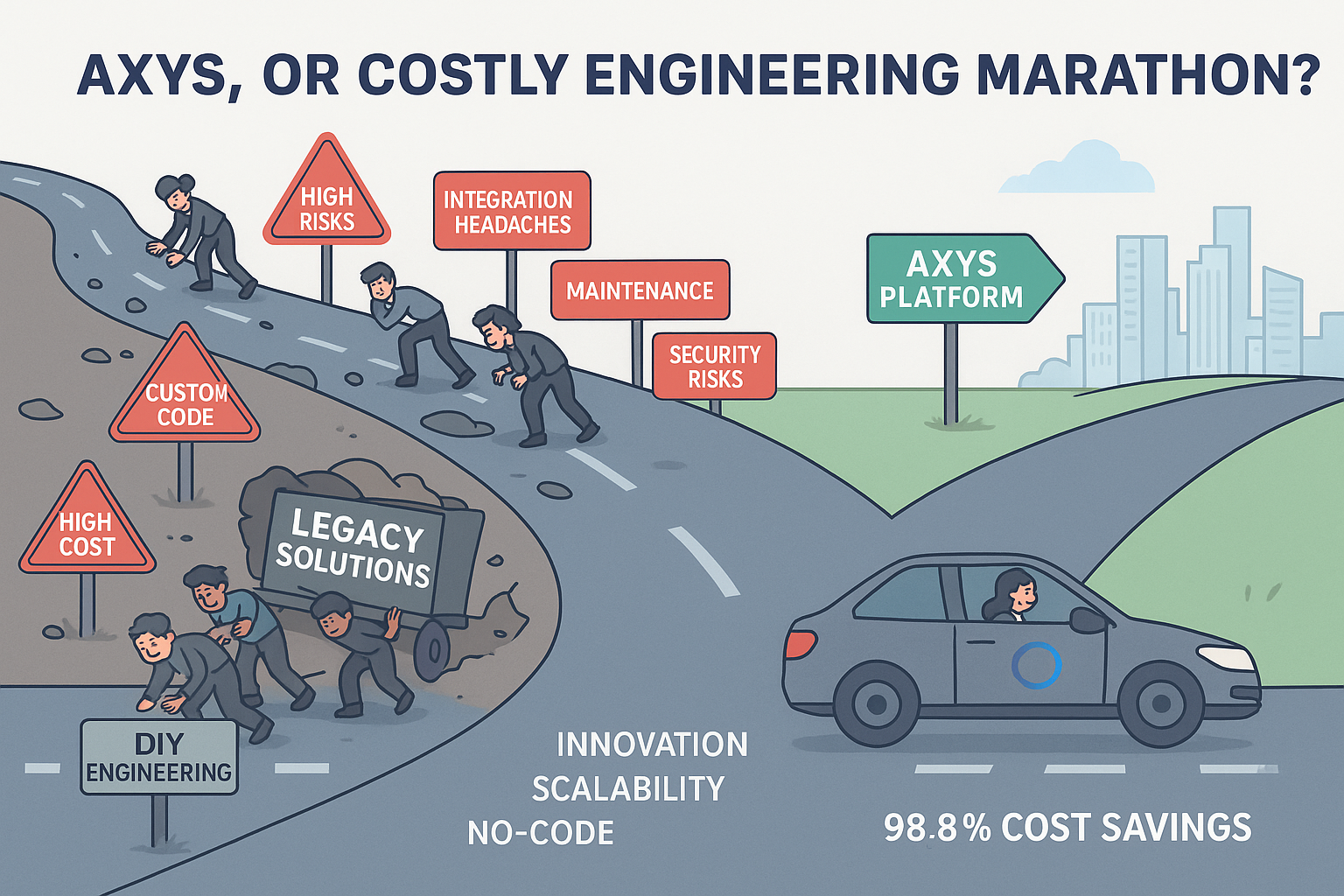Data silos are a common problem in organizations, where different departments or teams store and manage their own data independently, without sharing or integrating it with other parts of the organization. This can lead to a variety of issues, such as duplication of effort, lack of visibility into the organization’s overall data, and difficulty in making informed decisions.
It can occur for a variety of reasons, such as a lack of communication and collaboration between departments, a lack of standardization in data management practices, or a lack of technology or resources to integrate data across the organization.
Why Need to Break Through the Data Silos?
The effects of distributed data can be significant and far-reaching. For example, it can prevent an organization from gaining a comprehensive view of its customers, resulting in missed opportunities to cross-sell or upsell products. It can also make it challenging to identify trends or patterns in data, which can impede decision-making and hinder the ability to respond to changes in the market.
Applying the strategies to Break through the data silos requires a combination of technical, organizational, and cultural changes. Technical solutions include data governance, integration, quality, and analytics. Organizational changes include collaboration and communication between teams and departments and a shift towards a data-driven culture. Cultural changes include fostering a culture of data sharing and integration.
Different Types of Data Silos
There are several different types, including:
Functional
These occur when different departments or business units within an organization have their own separate databases and systems for storing and managing data.
Technical
These occur when different technologies or platforms are used to store and manage data, making it difficult to integrate and share information across the organization.
Geographical
These occur when data is stored and managed in different locations, such as different offices or countries, making it difficult to access and share information across the organization.
Data Ownership
These occur when different individuals or teams within an organization claim ownership over certain data sets, making it difficult to access and share information across the organization.
Data Governance
These occur when different policies, procedures, and standards are used to manage and govern data, making it difficult to integrate and share information across the organization.
Data Format
These occur when different data formats are used to store and manage data, making it difficult to integrate and share information across the organization. When different departments or teams have their own separate sets of data that are not easily accessible or shareable, it can lead to inefficiencies and duplicated effort. This can make it difficult for employees to do their jobs effectively and can lead to frustration and dissatisfaction.
Top Strategies to Break Through the Data Silos
Here are the top strategies to break through the distributed data:
Data Governance
Implementing a robust data governance framework can help break through the distributed data by establishing clear roles and responsibilities for data management, as well as policies and procedures for data access and sharing.
Data Integration
Utilize data integration tools and techniques to merge data from different silos into a centralized repository, making it more easily accessible and usable.
Data Quality
Implementing data quality controls, such as data validation, data cleaning, and data standardization can help ensure that data is accurate and consistent across distributed data warehouses.
Data Analytics
Utilizing data analytics tools and techniques can help identify patterns and insights across silos, providing a more holistic view of the data.
Collaboration
Encourage collaboration and communication between teams and departments to foster a culture of data sharing and integration.
Cloud-based solutions
Make use of cloud-based solutions that allow organizations to share and access data across silos and different locations easily.
Data Security
Implementing data security measures to protect sensitive data from unauthorized access and breaches can help to alleviate concerns about sharing data across silos.
Continuously Monitoring and Improving
Once you break down the data silos, it’s important to continuously monitor and improve the data governance framework, data integration technologies, and data sharing culture to ensure that the silos stay broken and that the organization can benefit from the data integration.
Frequently asked questions
Everything you need to know about AXYS Platform
AI, LLM, Prompting, and Search
Data Management and API Features
General AXYS Platform Overview
Integration and Connectivity
AI, LLM, Prompting, and Search
Yes, AXYS allows you to add both users and admins to the Chat AI interface. Admins can manage user access, set permissions, and oversee interactions, while users can securely access the chat to ask questions, explore data, and leverage AI insights. This flexible user management ensures your team collaborates efficiently while maintaining the right level of control and security.
Data Management and API Features
Yes, AXYS gives you full control over which fields and data are indexed from each connected source. Using the no-code interface, you can select or exclude specific fields, tables, or document sections both during initial setup and at any time afterward. You can easily add or remove fields—including new fields that appear in your sources—without writing a single line of code or redeploying the backend. This flexibility lets you optimize data storage, maintain privacy, and keep your indexing perfectly aligned with your business and compliance needs.
General AXYS Platform Overview
AXYS is deployed directly in your own cloud or on-premises environment, inheriting all your existing security controls, firewall rules, and compliance policies by default. The platform operates entirely within your private infrastructure, so your data never leaves your environment. AXYS works with your established security groups, identity management, and DevOps standards, ensuring seamless alignment with your organization’s best practices. All AXYS APIs are secured with robust authentication and tokenization, giving you full control over data access and permissions. For extra protection, AXYS can run entirely behind your firewall, maintaining strict privacy and regulatory compliance at all times.
AXYS is an all-in-one, no-code data orchestration platform designed to unify, clean, and connect all your business data—whether structured or unstructured—from databases, files, SaaS applications, and more. Unlike traditional data integration tools that often require months of engineering and complex coding, AXYS can be deployed and start delivering value within days. The platform automatically generates secure, AI-ready APIs, connects instantly to a wide variety of data sources, and prepares your data for advanced AI and large language model (LLM) projects. With AXYS, even non-technical teams can manage, analyze, and optimize data quickly and efficiently, removing engineering roadblocks and accelerating AI adoption for your business.
Integration and Connectivity
Yes, AXYS is designed to handle both structured and unstructured data seamlessly. The platform can connect to databases, spreadsheets, and other structured sources, as well as process unstructured content like documents, emails, PDFs, and more. This versatility ensures you can unify, analyze, and make use of all your business data—regardless of format—within a single platform.
Yes, AXYS can be deployed entirely within your corporate firewall with no need for external access. The platform runs securely on your own infrastructure—cloud or on-premises—so all data processing, indexing, and orchestration stay fully private and under your control. This setup ensures strict compliance with internal security policies and regulatory requirements, keeping your business data completely isolated from outside networks.
Adding or removing data connectors in AXYS is a simple, no-code process. You only need to provide your authentication credentials, and AXYS automatically connects to your data source, verifies the integration, and continuously monitors the connection for health and reliability. No engineering or manual setup is required, so you can easily manage all your connectors from a user-friendly interface. This makes it quick and effortless to update, expand, or streamline your data integrations as your business needs change.
Latest
From the blog
The latest industry news, interviews, technologies, and resources. View all postsAXYS, Or Costly Engineering Marathon?
Unlocking AI Agent Adoption: How AXYS Empowers Businesses to Scale AI with Confidence
Still thinking about it?
Let’s get started on something great
Get startedOne Comment on “5 Proven Strategies to Break Through the Data Silos”
Comments are closed.



Data Fabric 101: The Next Generation of Enterprise IT - Unlock your data potential with AXYS Platform says:
[…] Data silos exist when different parts of an organization cannot access shared information between departments and lines of business. Utilizing data fabrics makes accessing up-to-date information across all areas easy while allowing customers and suppliers easy access too. This helps organizations operate more efficiently by quickly understanding changing customer needs or supplier forecast changes; something traditional manual processes can’t do in today’s competitive environment. […]